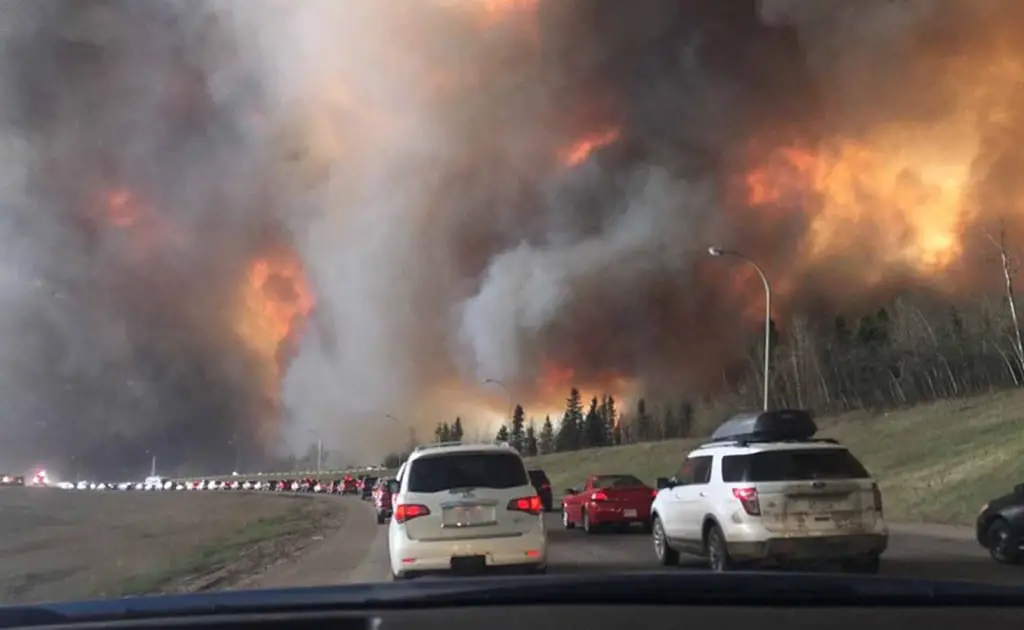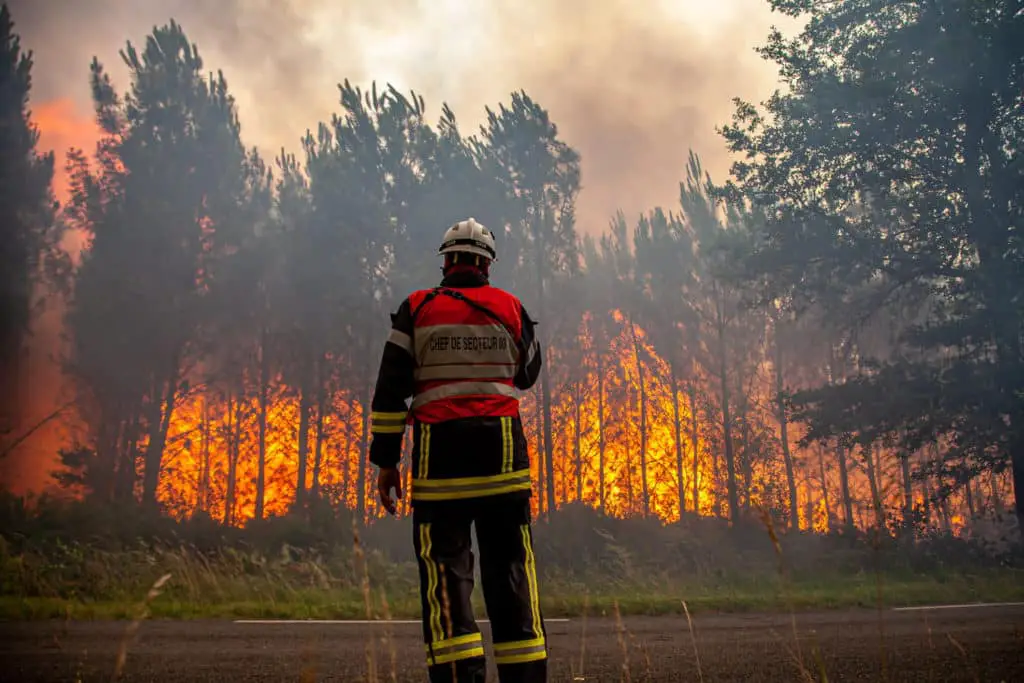News
Canada Wildfires Forcing Thousands to Flee Their Homes

Canada Wildfires that have been raging throughout the country for the past week have forced thousands of people to abandon their homes, with many unsure when they will be able to return.
Firefighters battling more than 100 wildfires across Canada may receive brief relief in some areas as a major mid-week storm moves through western and central Canada, bringing higher possibilities of rain and blasts of cool air.
Nonetheless, some dangerous fires are burning within miles of neighborhoods. Fire authorities warn that minor changes in weather or wind direction can suddenly put adjacent homes and businesses at jeopardy.
More than 6,000 people have fled Fort McMurray, Alberta, since Tuesday, as a 51,000-acre fire rages less than 5 miles from the city’s edge. Residents should count on being gone from their houses until at least May 21, and possibly longer, according to the regional municipality.
The fire near Fort McMurray remained active Wednesday, but winds were forecast to start pushing it away from the city and its key roadway, according to Alberta Wildfire Information Officer Josee St-Onge. Rain showers are expected to start Wednesday night and last until tomorrow, with a total rainfall of up to one inch.

Canada Wildfires Forcing Thousands to Flee Their Homes: CBC Image
Firefighters braving the flames of the wildfires
Firefighters have been working around the clock to keep the flames at bay, employing water helicopters with night vision. Firefighters, often defending their own villages, have also worked arduous and risky shifts.
“To the firefighters braving the flames to defend Fort McMurray and other areas of the province, we appreciate your heroic efforts more than we can say and we pray for your safe return,” the premier of Alberta, Danielle Smith, said on Wednesday.
For many Fort McMurray locals, the smoke-blackened skies and nervous evacuations bring back sad memories of “The Beast,” a devastating 2016 fire that forced 90,000 people to evacuate and caused billions of dollars in damage to homes and businesses.
Resident Jocelyn Routhier, whose neighborhood has yet to be told to evacuate, has observed from her back porch as the situation becomes disturbingly identical to the last disaster. She posted two uncanny photos of the fires, shot eight years apart.
“This is a déjà vu that I would prefer avoid. Let’s hope it doesn’t become a reality,” Routhier wrote in a social media post accompanying the photographs.
Jocelyn Routhier, a Fort McMurray homeowner, captured the 2016 and May 2024 flames from the same position on her porch.
Every day, new fires break out across Canada, and numerous out-of-control blazes threaten densely populated areas, leading scores of evacuated citizens to seek refuge in hotels, emergency shelters, and camp and RV sites.

Cooler temps, rain helping fend off wildfires: Image Global News
Anticipated Rains
Mackenzie Spenrath is one of roughly 5,000 individuals forced to evacuate the Fort Nelson area of British Columbia, where the 31,000-acre Parker Lake Fire is blazing barely 1.5 miles from the town. He told CNN that he has grown obsessed with watching news and surfing through social media, “trying to figure out if my town is still standing.”
Fort Nelson fire crews may benefit from less than an inch of rain anticipated Wednesday night and Thursday evening. However, the quantity of precipitation required to offset drought conditions and extinguish the fires is significantly greater, according to the British Columbia Wildfire Service.
“It’s not completely hopeless, obviously. But the fire is so close to town that it’s difficult to imagine anything but the worst,” Spenrath explained.
Extremely dry conditions are also causing issues for firefighters battling a fire that has reached within a mile of the Cranberry Portage town in western Manitoba. Approximately 580 individuals have been evacuated, and there is no anticipated time for their return.
“Because the conditions are so extremely dry up there, the fires burned down deep,” Earl Simmons, the Manitoba Wildfire Service’s director, told CBC. “So the firefighters have to get in there and dig down into the dirt to extinguish it. And we’re not just talking a few inches; in some cases, we’re talking meters deep.
Warming circumstances induced by human-made climate change exacerbate the dry conditions that are fueling Canada’s wildfires.
“This region has experienced multiple years of drought, with a below-normal snowpack this past winter,” said Ben Boghean, fire behavior specialist for the BC Wildfire Service. “As a result of this, our forests in the Fort Nelson zone are very receptive to new fire ignitions and rapid rates of spread.”
Declining snow, rising temperatures, and worsening droughts are all signs of climate change, and Environment Canada predicts that they will continue to drive larger and more destructive fires across Canada.
News
Britain Must Be Ready for War in 3 Years, Warns New Army Chief

The new head of the Army has stated that Britain must be prepared to fight a war within three years.
Gen Sir Roland Walker has issued a warning about a variety of risks in what he calls a “increasingly volatile” environment.
However, he stated that war was not inevitable and that the Army had “just enough time” to prepare to prevent conflict.
He stated that the Army’s fighting capacity would be doubled by 2027 and tripled by the end of the decade.
Gen Walker warned that the Britain was under threat from a “axis of upheaval” in his first speech as Prime Minister on Tuesday.
Among the primary concerns confronting the Britain in the next years, as noted by the general in a briefing, is an enraged Russia, which may seek vengeance on the West for helping Ukraine, regardless of who wins the war.
He stated: “It doesn’t matter how it finishes. I believe Russia will emerge from it weaker objectively – or completely – but still very, very dangerous and seeking some form of retaliation for what we have done to assist Ukraine.”
Britain’s Government Defence Review and Military Challenges
He also warned that China was determined to retake Taiwan, and Iran was likely to seek nuclear weapons.
He stated that the threats they posed may become particularly acute in the next three years, and that these countries had formed a “mutual transactional relationship” since the war in Ukraine, sharing weaponry and technology.
However, he stated that the path to conflict was not “inexorable” if the UK re-established credible land troops to assist its deterrent strategy for avoiding war.
In his speech, he described his force of slightly over 70,000 regular troops as a “medium-sized army” and made no direct call for additional resources or men.
However, he pushed the British Army to adapt swiftly, focussing on technology such as artificial intelligence and weaponry rather than numbers.
His ultimate goal is for the Army to be capable of destroying an opponent three times its size.
This would entail firing quicker and farther, he said, aided by lessons learnt from the Ukraine war.
The general’s speech at the Royal United Services Institute land warfare conference comes only one week after the government began a “root and branch” defence review to “take a fresh look” at the challenges facing the armed services.
Defence Secretary John Healey launched the assessment, describing the existing status of the armed forces as “hollowed-out” and stating that “procurement waste and neglected morale cannot continue”.
According to the most recent Ministry of Defence (MoD) numbers from April 2024, the Britain’s regular Army forces total 75,325 troops (excluding Gurkhas and volunteers).
That figure has been declining in recent years, as recruiting has failed to match retention. The previous Conservative administration lowered the planned headcount from 82,000 to 72,500 by 2025.
Members of the NATO military alliance have agreed to spend at least 2% of GDP on defence by 2024, but several countries are unlikely to fulfil this goal.
The Britain presently spends 2.3% of its GDP on defence. Prime Minister Sir Keir Starmer has previously stated that the defence review will include a “roadmap” for increasing this to 2.5%, however he has yet to provide a date for this promise.
Source: BBC
News
Katie Ledecky Hopes For Clean Races At Paris Olympics In The Aftermath Of The Chinese Doping Scandal

PARIS — Katie Ledecky is looking for clean Olympic races. On Wednesday, Hope had pretty much reached her limit.
The American swimmer hopes to add to her six gold medals as she competes in the 400, 800, and 1,500 meters at the Paris Games. Her program starts with the heavy 400 on Saturday, featuring Ariarne Titmus and Summer McIntosh.

Katie Ledecky | ESPN Image
Katie Ledecky Hopes For Clean Races At Paris Olympics In The Aftermath Of The Chinese Doping Scandal
The 27-year-old Katie is competing in her fourth Summer Olympics, but the first since a doping scandal involving almost two dozen Chinese swimmers who tested positive for a banned chemical before the Tokyo Games — yet were permitted to compete with no consequences. The controversy has raised serious worries regarding the effectiveness of anti-doping initiatives.

Katie Ledecky | Vogue Image
“I hope everyone here is going to be competing clean this week,” Ledecky claimed. “But what truly counts is, were they training cleanly? Hopefully this has been the case. Hopefully, there has been worldwide testing.”
The International Olympic Committee has expressed concern over the ongoing US investigation into possible doping by Chinese swimmers. While awarding the 2034 Winter Olympics to Salt Lake City on Wednesday, the IOC urged Utah officials to do whatever they could to stop the FBI investigation.
“I think everyone’s heard what the athletes think,” Katie added. “They seek transparency. They want more answers to the remaining questions. At this point, we are here to race. We are going to race whoever is in the lane next to us.
“We are not paid to conduct the tests, so we trust those who follow their regulations. That applies both today and in the future.

Katie Ledecky | ESPN Image
Katie Ledecky Hopes For Clean Races At Paris Olympics In The Aftermath Of The Chinese Doping Scandal
SOURCE | AP
News
London Heatwave Alert: High Temperatures Set to Soar to 29C Next Week

As the summer holidays begin, London may experience an official heatwave with temperatures reaching up to 29 degrees Celsius.
The Met Office predicts a long period of sunny and dry weather for London after a soggy spring and summer.
After a cloudy day on Saturday, temperatures are expected to reach 27C on Sunday, with lots of sunlight.
On Monday and Tuesday, temperatures are forecast to peak at 29 degrees Celsius. Monday is forecast to offer more sunlight, while Tuesday may see some gloomy weather.
Temperatures are expected to remain in the high 20s next week, with lows of approximately 18C.
According to the Met Office, a heatwave is “an extended period of hot weather relative to the expected conditions of the area at that time of year, which may be accompanied by high humidity.”
In the United Kingdom, a heatwave is proclaimed when daily temperatures meet or surpass a certain level for at least three consecutive days.
In London, the heatwave threshold is 28 degrees Celsius.
The Met Office reported that the UK is experiencing hotter and wetter weather on average due to climate change.
The UK experienced its warmest May and April on record this year, despite damp and dismal conditions in many areas.
According to the Met Office’s State Of The UK Climate 2023 report published on Thursday, the UK experienced historic levels of extreme weather last year.
In the United Kingdom, 2023 was the second warmest year on record, bringing storms, flooding, strong heatwaves, and rising sea levels; only 2022 was warmer.
It was 0.8°C higher than the average from 1991 to 2020, and 1.66°C higher than the 1961 to 1990 average.
However, 2023 will be a “cool year” in comparison to 2100, based on the planet’s warming trajectory.
The government’s plan to adapt to the hazards presented by climate change is currently being challenged in the High Court by campaigners who allege the Tory administration’s July 2023 National Adaptation Programme (NAP) fails to adequately address 61 concerns.
Source: The Standard
-
World2 weeks ago
Former President Trump Survives Being Shot at Pennsylvania Rally
-
Tech4 weeks ago
Huawei Launches 5G-A Pioneers Program at MWC Shanghai 2024: Paving the Way for a Connected Future
-
Tech4 weeks ago
ChatGPT Answers Undiscovered Questions and Outperforms Students.
-
Sports4 weeks ago
NBA Draft: Kyle Filipowski Withdraws Unexpectedly From The First Round
-
News4 weeks ago
US Supreme Court Rejects Drug Deal that Protects the Sackler Family
-
Health4 weeks ago
US Health Agency Issues Dengue Virus Infection Warning
























